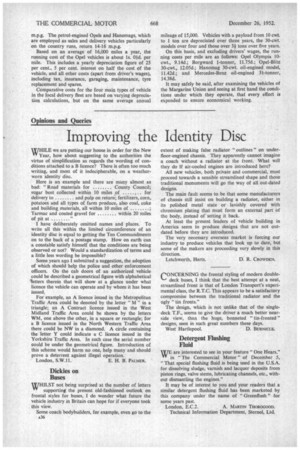Opinions and Queries
Page 46

If you've noticed an error in this article please click here to report it so we can fix it.
Improving the Identity Disc
IV-11LE we are putting our house in order for the New vv Year, how about suggesting to the authorities the virtue of simplification as regards the wording of conditions attached to a B licence? There is often too much writing, and most of it indecipherable, on a weatherworn identity disc. Here is an example and there are many almost as bad: "Road materials for County Council; sugar beet collected within 10 miles of for delivery to and pulp on return; fertilizers, corn, potatoes and all types of farm produce, also coal, coke and building materials, all within 10 miles of Tarmac and coated gravel for within 20 miles of pit at I have deliberately omitted names and places. To write all this within the limited circumference of an identity disc is equal to getting the Ten Commandments on to the back of a postage stamp. How on earth can a constable satisfy himself that the conditions are being observed or not? Would a standardization of terms and a little less wording be impossible? Some years ago 1 submitted a suggestion, the adoption of which should help the police and other enforcement officers. On the cab doors of an authorized vehicle could be described a geometrical figure with alphabetical letters therein that will show at a glance under what licence the vehicle can operate and by whom it has been issued.
For example, an A licence issued in the Metropolitan Traffic Area could be denoted by the letter " M " in a triangle; an A Contract licence issued in the West Midland Traffic Area could be shown by the letters WM, one above the other, in a square or rectangle; for a B licence issued in the North Western Traffic Area there could be NW in a diamond. A circle containing the letter Y could indicate a C licence issued in the Yorkshire Traffic Area. In such case the serial number could be under the geometrical figure. Introduction of this scheme would harm no one, help many and should prove a deterrent against illegal operation. London, S.W.1I. E. H. B. PALMER.
Dickies on Buses
WHILST not being surprised at the number of letters supporting the present old-fashioned outlook on frontal styles for buses, I do wonder what future the vehicle industry in Britain can hope for if everyone took this view.
Some coach bodybuilders, for example, even go to the A36 extent of making false radiator " outlines " on underfloor-engined chassis. They apparently cannot imagine a coach without a radiator at the front. What will they do if air-cooled engines are introduced here? All new vehicles, both private and commercial, must • proceed towards a sensible streamlined shape and those traditional monuments will go the way of all out-dated designs. The main fault seems to be that some manufacturers of chassis still insist on building a radiator, either in its polished metal state or lavishly covered with chromium plating that must form an external part of the body, instead of setting it back. At least the present leaders of vehicle building in America seem to produce designs that are not outdated before they are introduced. The very necessary overseas market is forcing our industry to produce vehicles that look up to date, but some of the makers are proceeding very slowly in this direction.
Letchworth, Herts. D. R. CROWDEN.
CONCERNING the frontal styling of modern double deck buses, I think that the best attempt at a neat, streamlined front is that of London Transport's experimental class, the R.T.C. This appears to be a satisfactory compromise between the traditional radiator and the ugly "tin fronts." The design, which is not unlike that of the singledeck T.F., seems to give the driver a much better nearside view, than the huge, bonneted " tin-fronted " designs, seen in such great numbers these days. West Hartlepool. D. BURNICLE.
Detergent Flushing Fluid
WE are interested to seem your feature " One Hears," " in "The Commercial Motor" of December 5, " That special flushing fluid is being used in the U.S.A. for dissolving sludge, varnish and lacquer deposits from piston rings, valve stems, lubricating channels, etc., without dismantling the engines." It may be of interest to you and your readers that a similar detergent flushing fluid has been marketed by this company under the name of " Greenflush " for some years past. London, E.C.2. A. MARTIN THOROGOOD. Technical Information Department, Sternol, Ltd.












































































